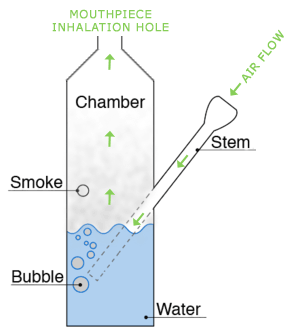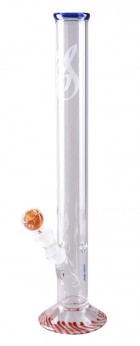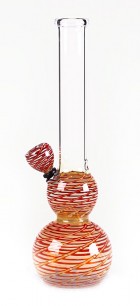This is a guide mostly for beginners that covers the basics of bongs ( water pipes ), based on this info you’ll be ready to go out there and buy your first bong and not look like a total noob !
So Why Would Anyone Want To Buy a Bong?
Whether you’re new to smoking weed or you’re a veteran stoner, you may be wondering why you’d need a bong. After all, you can get a perfectly good hit from a joint or a pipe, so why invest in one of these fancy contraptions?
Water pipes, or bongs, aren’t as fancy as they may look to a new buyer. They are pretty straightforward, but they do come in endless varieties. The basic function of any bong is to push smoke up through a volume of bubbling water. This filters the smoke somewhat before you inhale it.
What are some advantages of bongs over other pipes and joints?
- The filtration process cools and smoothes the smoke. Making bigger, longer and deeper inhalation possible. You can take 1 huge gigantic rip and be good, so you also use less weed, which leads me to the next point !
- Less is more: The bowl of a bong requires less weed than a joint; bongs releases less smoke while idle. Most of the smoke gets pulled straight into the bong chamber, also reducing waste. You can easily extinguish the bong between hits. Weed is expensive. Bongs save you money by conserving your weed.
- Enhanced experience : when you smoke in a bong, you can put many different kind of liquids in the chamber, the usually is water but you can put alcohol, juices, mint whatever you like.
You may be thinking all of that is great, but aren’t bongs hefty and awkward? In reality, there are so many sizes and variations on bong design that you should be able to find one that is small and portable if that’s what you need. There are even padded bags you can buy to carry and store your bong. Bongs have a wide price range too. Whatever your budget, there’s a bong to fit it.
What are the Most Common Types of Bongs?
Bongs come in all shapes and sizes and are as unique as the people who smoke them. They can be very simple with just one tube, or be very complex with multiple tubes. Some bongs are enormous and hold a gallon of water while others are tiny and portable. Bongs can be made of all kinds of materials: Glass bongs are generally favored, but acrylic, plastic, metal and ceramic bongs tend to cost less and are harder to break. Many bongs are designed with aesthetic qualities in mind and double as impressive works of art. Others are plain and straightforward. There are major brand bongs and one of a kind artisan bongs. Every bong provides a different smoking experience.
Some popular bong shapes include:
Straight Tube
The Straight Tube Bong - This model features a solid tank joint reinforcement part connecting the downtube and the bowl, which is usually the weakest part of the bong. Due to this reinforcement this bong is IDEAL for beginners as accidents are bound to happen, this bong is strong enough to take it. It is also pretty cheap at 60$.
Beaker Bottom
The Beaker Bong - This awesome beaker bottom bong features ice notches, a diffuser downtube and a three arm percolator, all this for the smoothest hits. Really great value bong at only 75$ !
Bubble Bottom
The Bubble Bong - This beautiful piece features color changing glass and elaborate red swirls art work. Keep in mind this is all done by hand, like all glass bongs. This piece is only 50$.
But this is by no means the limit to bong shapes – the variations are endless!
Bong Basics – How Does a Bong Work?
When you light the marijuana bud in the bowl, smoke is drawn through the downstem and into the chamber. Once there it forms bubbles which float up through the water (or other liquid). The liquid filters the smoke of impurities and depending on the kind of liquid you use, may add to the experience.

Cold water or water with ice is a common choice for smokers, as are herbal teas and alcohol. Note though that alcohol will chew up some of the THC (tetrahydrocannabinol – the psychoactive substance in your weed that gets you high) in your hit, as will milk or cream. THC isn’t soluble in water but is soluble in both those substances (see http://en.wikipedia.org/wiki/Cannabis_foods). Sugary liquid will gunk up the inside of your Bong, so don’t overdo it.
There is another kind of bong called a Waterfall or Gravity bong. These use draining water from the chamber to pull smoke into the chamber, but they’re pretty uncommon. The types of bongs pictured above are the ones you’re most likely to come across.
You may be wondering how high to fill the chamber of your bong. If your bong has a carb (more on that later), make sure to fill below that point so that your bong won’t leak if you have to pick it up or tilt it. The stem hole where the downstem connects to the chamber should be below the water line.
Generally speaking, the greater the volume of the water in your bong, the better filtration you’ll receive from your bong. Volume should not be confused with distance though. The greater that distance the bubbles need to travel through the water, the greater the drag you’ll experience and the harder your lungs will have to work to pull the smoke through the bong.
What are the Parts of a Bong?
- Tube: The body of your bong.
- Mouthpiece: The opening you smoke from. This may be a hole at the top of the tube or may instead be affixed to the main tube by another tube.
- Base: The shape of the base can vary; in straight tubes bongs it is just an extension of the tube, in beaker bottom bongs the base has a beaker shape, and in bubble bottom bongs the base is bulbous. Together, the base and tube form the bong’s chamber. This is where you put the water or other liquid in your bong.
- Bowl: This is where your weed goes. Bowls can either be immobile or they can be designed as “sliders.” Slider bowls can be pushed out of the way to create an opening which will cause the smoke to leave your bong and clear out the chamber.
- Carb hole, aka. Carburator aka. Shotgun Hole: If you don’t have a slider, you probably have a carb, which is a hole in the tube of your bong. When covered, smoke is able to fill the chamber; when uncovered, the smoke can clear out of the chamber. Not all bongs have carbs.
- Downstem: This is the link between the bowl and the chamber of the bong. The smoke travels from the bowl through the downstem when you inhale. From there it enters the water to form bubbles.
- Stem hole: Where the downstem connects to the base. Can be glass-on-glass (GonG) or take the form of a rubber seal.
- Ash catcher: Not all bongs have ash catchers. Ash catchers are filters for any debris that gets pulled toward the downstem from the bowl. Ash catchers will keep your water pure but they’ll also introduce some drag.
- Ice catcher or ice notch: notches in the tube which allow you to put ice cubes in the tube through which the smoke will pass after coming out of the water.
- Diffusers: A variation on the simple downstem which includes a number of smaller holes instead of a single opening at the end. Diffusers smooth, thicken and cool smoke but also make the pull a little harder ( more force is needed to inhale ).
- Percolators: These are supplementary water chambers which provide a similar effect to smoke as diffusers. Like diffusers, percolators can augment drag. Both can improve the quality of the smoke.
How do you Smoke a Bong?
- Fill up your bong with water or your liquid of your choice. The water should be covering the stem hole (the connection to the downstem) but if your bong has a carb, make sure the water level is well below the carb hole.
- Either set your bong down somewhere where it won’t fall over and sit down to smoke, or hold it by the base while standing.
- The next step is to milk your bong, which means to fill up the chamber with smoke. Bring your lips to the mouthpiece and light the edge of the bowl with a cigarette lighter or a match.
- Inhale slowly. First you’ll hear the bubbling sound begin as the smoke reaches the water, and then you’ll notice the smoke gradually filling the chamber.
- When your bong is good and milked and you’re ready to take a pull, you can either inhale at this point, or, if you need to exhale, you can exhale through your nose or remove the slide (or uncover the carb hole) and cover the mouthpiece of the bong while you exhale. Do not exhale into the bong, or your breath will push the water through the downstem and straight into your weed.
- When you’re ready to inhale, start out gradually and then increase your lungpower. Get as much smoke as you can; for beginners this may take a few tries. Smaller bongs are easier for newer smokers.
- Don’t let your breath out all at once, or you’ll lose some of the potency of the hit. Hold your breath for a couple of seconds before exhaling.
- If you have some trouble at first, don’t worry about it – smoking through a bong takes practice, like everything else!
Bong Maintenance
After you’re done smoking, you should always clean out your bong. Cleaning your bong is easy. Empty the water from the chamber and dry out your bong as best you can to protect the glass. If you have difficulty reaching the inside of the downstem you can use a pipe cleaner. Empty the bowl and clean out your ash catcher. If you need to scrape out any debris, a small screwdriver made for computers or jewelry can be helpful and precise. Isopropyl Rubbing Alcohol is helpful for cleaning out debris since it neutralizes THC. Store your bong somewhere safe like a bong bag or inside some other padded container, and remember to keep it out of sight of windows.
Buying a Bong
Hopefully now you have a better idea what to look for in your first bong and how to use it and take care of it once you’ve picked one out. When you visit the head shop, be sure to refer to the bong as a “water pipe.” Bongs, technically, can be used to smoke tobacco and other substances, but the word “bong” has become heavily associated with marijuana and some head shop owners will not feel comfortable serving you unless you call it a water pipe. The overwhelming majority will not care though ![]()
Smoking is a very personal experience and everyone looks for different features in a bong. Do some research and follow your instincts while you’re shopping and you’ll eventually find the bong that’s perfect for you. In the meantime, check out the rest of our site for more information to help you make your choice.
I hope you enjoyed this guide, I think it covers the basics pretty well, but let us know if we forgot something !



